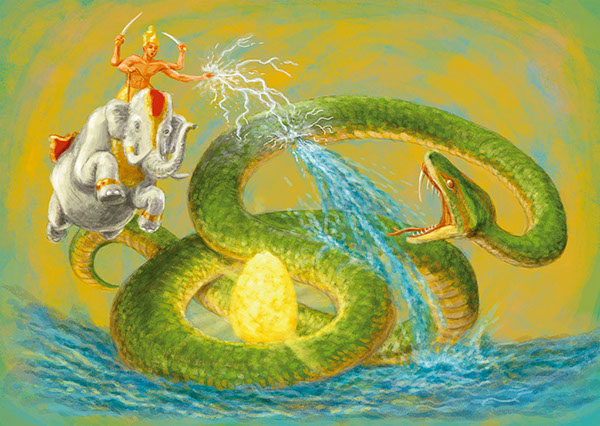Keyword: Thunder
In my previous blogs I have introduced some serpent looks characters both in east and west legend, as Fuxi, Cecrops, Echidna, Hydra and so on, today I would like to list some groups consist of legendary hunters and their preys, which also relates to serpent.
As the success of Marvel film THOR, people over world have meet this hero who fight with aliens and save the world, actually in North mythology, Thor is a hammer-wielding god associated with thunder, lightning, storms, oak trees, strength, the protection of mankind, and also hallowing, healing and fertility. The cognate deity in wider Germanic mythology and paganism was known in Old English as Þunor and in Old High German as Donar, stemming from a Common Germanic *Þunraz (meaning "thunder").

One of Thor's most important heroic deeds is, fighting with Jormungand. In Norse mythology, Jormungand also known as the Midgard Serpent, or World Serpent, is a sea serpent, the middle child of the giantess Angrboða and Loki. According to the Prose Edda, Odin took Loki's three children by Angrboða, the wolf Fenrir, Hel and Jormungand, and tossed Jormungand into the great ocean that encircles Midgard. The serpent grew so large that he was able to surround the earth and grasp his own tail. As a result, he received the name of the Midgard Serpent or World Serpent. When he lets go, the world will end.
There are three preserved myths detailing Thor's encounters with Jormungand, however in the final battle, when Jormungand came out of the ocean and poisoned the sky, Thor killed Jormungand and then walked nine paces before falling dead, having been poisoned by the serpent's venom. Both sides end in death.

Another serpent monster killer is Indra, from Vedic myth of Hinduism, who is the god of the atmosphere, storms, rain, and battle. Indra is the most celebrated Vedic god, with more than 250 hymns addressed to him. Ancient legends depict him as the most powerful foe of various demonic powers preventing the rain and the dew from nourishing the earth. In later Hinduism, Indra is subordinate to the gods Brahma, Shiva, and Vishnu. He is depicted as penitent, somewhat dull-witted, and often perplexed by more popular gods and heroes. In Hindu art Indra is frequently represented as having four arms: one hand holds a thunderbolt, the second wields a spear, the third holds a quiver of arrows, and the fourth carries a net of illusions and a hook for entrapping foes.

in the Rig Veda, which is a collection of antique Hindu hymns, Indra is described as the king of the gods. He has authority over the sky and the power to make rain using his weapon the thunderbolt. Indra is depicted as a man with four long arms riding a white elephant. Indra is the god of battle. Before each battle, he drinks a vast quantity of soma which makes his belly enormous. The soma is a divine juice. It is said that this juice empowers him to accomplish his heroic missions. His strength defeated the serpent Vritra who had swallowed all the waters of the world bringing a tremendous drought. Indra split the belly of the serpent with his thunderbolt, releasing the waters and generating life. By killing the serpent, Indra separated land from ocean, and caused the sun to rise.

The interesting thing is, Thor and Indra have much in common. 1, they are both god of thunder, and once their leadership position is very high. 2, Both of them have powerful weapons which are Thor Hammer and Vajra, and their weapons are a symbol of thunder, can be used for throwing, also have been used as amulets for posterity. 3, Vritra killed by Indra blocked headwaters in the world, whereas Jormungand killed by Thor blocked the entire earth.
Besides these two heros, there are more serpent hunters in different legends, like Hou Yi (Ancient China), Yu the Great(Ancient China), Heracles (Ancient Greek), Thraetaona (Persia), Michael (Bible), Susanowo (Japan)...
Before I end this topic, let's have some more related extension content. In Chinese mythology, Lei Gong or Lei Shen, is the Chinese traditional religious and Taoist deity, who is the lord of thunder as well. In Taoism, when so ordered by heaven, punishes both earthly mortals guilty of secret crimes and evil spirits who have used their knowledge of Taoism to harm human beings. Lei Gong carries a drum and mallet to produce thunder, and a chisel to punish evildoers. He rides a chariot driven by a young boy named A Xiang.
Lei Gong is depicted as a fearsome creature with claws, bat wings, and a blue face with a bird's beak who wears only a loincloth. Temples dedicated to him are rare, but some people honor him in the hope that he will take revenge on their personal enemies.
Reference:


